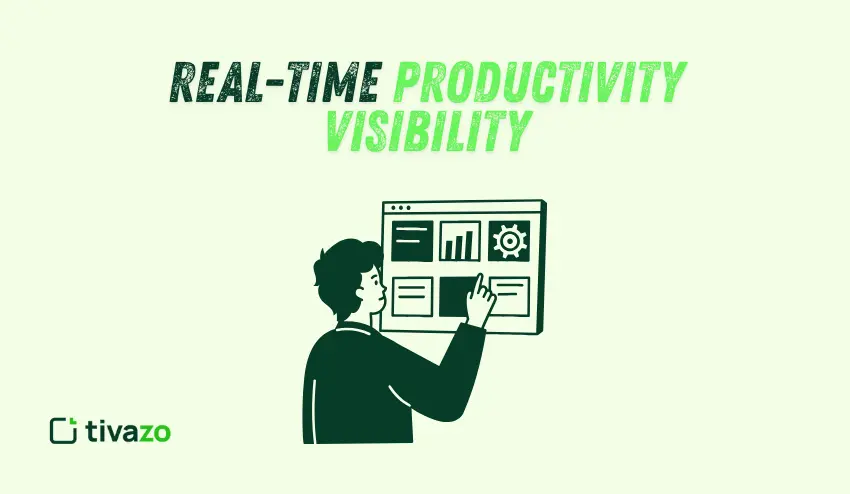Do you find yourself feeling unproductive, feeling busy yet still questioning if you are really productive? Many professionals mistake activity for productivity. You might find yourself spending time writing emails, attending meetings, or multitasking, but you may still feel unproductive by the end of your day.
The first step to learning to feel productive is understanding why you feel unproductive. Many times, it is not a matter of working harder but working smarter. If you utilize data and measurable metrics, you can determine the amount of your workday that is spent on productivity versus distractions.
In this blog, we will be going over 7 strategies that you can apply to start to feel productive again with the use of data, measurable goals, and productivity tools.
Understand Why You Feel Unproductive
1. Not Being Clear About Your Goals.
One primary reason that people are feeling unproductive is a lack of clarity in regard to the goals they are pursuing. Without SMART goals – Specific, Measurable, Achievable, Relevant, and Time-bound – individuals can drift throughout the day, accomplishing tasks that seem important in the moment but do not create any meaning in their day.
- Impact on productivity: minimal focus, high stress, wasted time
- Data-driven fix: Track the work you do and measure the impact. Are you creating results with your work?
When you have clearly defined goals, you create a map for your day, reduce uncertainty, and make sure your efforts actually lead to a meaningful impact. Even a small measurable goal achieved in the early part of the day can create momentum to reduce that nagging feeling unproductive.
2. Constantly Being Distracted
Are you routinely checking hard to resist notifications, social media, or emails to avoid working? Distractions like these do take away from your time for deep work tasks and add to the feeling unproductive.
- Data-driven insight: There are tools and apps available, such as RescueTime or Toggle, that can provide clarity on how much time was spent on distractions in your task versus productive work.
Awareness is the first step. Many individuals underestimate how many interruptions occur across their day, and also overestimate how many hours are being spent on focused work. Once you measure your pattern of distractions, you can strategize with purposeful scheduling, for example, scheduled times for checking emails or block time for focused work can offer you better protection against your distraction baselines of feeling unproductive.
3. False Beliefs About Multitasking
You may think multitasking makes you feel efficient, but research has shown it hurts overall productivity by 40%. Each context switch can take time and energy, which can still leave you with the feeling unproductive when, in fact, you are just busy.
Concentrating on one task at a time improves overall quality, and you will be able to accomplish more in a shorter period of time. When you put together single-tasking with a tracked work time made up of intervals, such as the Pomodoro Technique, you can materially decrease wasted time and feel more of a sense of accomplishment.
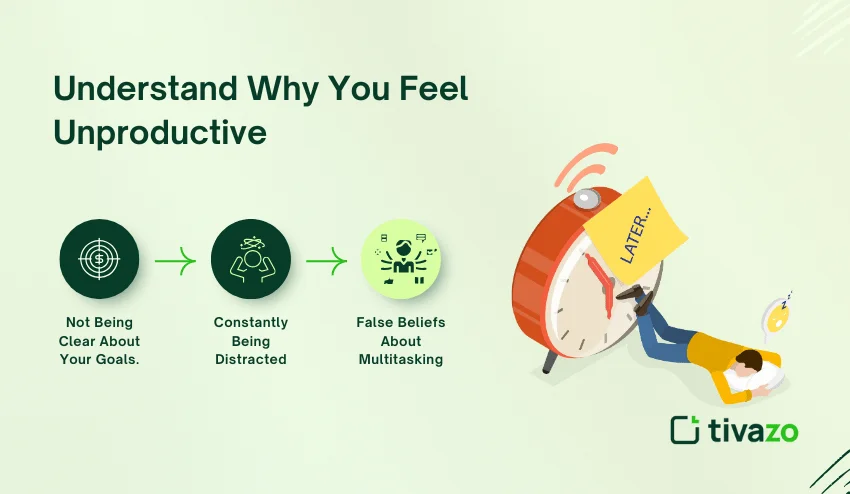
Track Your Time to Identify Gaps in Your Productivity
1. Why Tracking Time is Important
Have you tracked your time recently to find out where it really goes? In my experience, most people estimate they are productive 80% of the day or more, based on a gut feeling and not actual data. Data tends to tell a different story.
For example, you may assume you spent 2 hours on client work, but your time tracking app shows you only spent 1 hour on deep work.
2. Recommended Tools for Tracking Your Time
- Toggl: Simple task tracking by project.
- Clockify: Free time tracker with report builder/ functionality.
- RescueTime: Logs your time automatically based on apps and websites.
3. Example Table to Track Your Daily Time.
| Task | Planned Hours | Actual Hours | Productivity Rating |
| Client Work | 3 | 2.5 | High |
| Email Management | 1 | 2 | Low |
| Social Media / Scrolling | 0.5 | 1.5 | Medium |
| Team Meetings | 2 | 2 | Medium |
| Reporting / Analysis | 1 | 1.5 | High |
From there, you can see where your time is going and make appropriate changes to your schedule, knowing all of your activities.
Strategies that are Data-Driven to Overcome the Feeling of Unproductive
1. Establish SMART goals and metrics
Clearly defined goals result in a clear purpose and direction for your day. If you break your big goals down into smaller and trackable goals, it’s easier to pay attention to a smaller portion of your overall task.
- You will want to keep track of what you’ve completed and the deadlines, and the outcomes.
- Example: Instead of “work on report,” I will have a goal of “complete 3 pages of the financial report by 3 PM.”
By establishing SMART goals, you decrease uncertainty and give yourself tangible checkpoints, which directly combat the feeling unproductive. If you can see the measurable progress, the feeling of wasting time begins to diminish.
2. Prioritize Activities by Using the Eisenhower Matrix
Separate your to-do list into four quadrants:
| Quadrent | Action Plan |
| Urgent & Important | Do first! |
| Important, Not Urgent | Schedule for later |
| Urgent, Not Important | Delegate! |
| Neither Urgent, & Not Important | Eliminate |
This process provides some assurance and mindfulness around activities that generate the greatest or the least amount of wasted time over the period of time in which the activities take place to maximize efforts and not feeling unproductive. You can reference your previous task data to determine what activities, if any, really contribute to your goals уou set.
3. Utilize the Pomodoro Technique
Work in 25-minute focused segments with a break for 5 minutes. Record this interval in your productivity tool.
- Data Benefit: You can compare completed Pomodoros for important versus low-value tasks.
Tracking these intervals will allow you to measure your focus and productivity. It will help you to know when your most productive times are and when the feeling unproductive is likely to occur.
4. Reduce Distractions with Insights
Relying solely on our perceptions is often an even worse feeling unproductive. Instead:
- Identify apps with heavy, redundant notifications that disrupt your focus.
- Make use of website blockers in periods of high focus.
- Establish boundaries with colleagues about uninterrupted work time.
Watching data from time-tracking apps can help you identify the exact distractions that are swaying the course of your workday. The same information will provide insights you can act on to take control of your workday.
5. Get Your Tasks Aligned with Your Values
- Tasks aligned with one’s personal or work-related values will tend to be more focus-worthy and fulfilling.
- Use your data to reflect on which of your tasks gave you the greatest sense of accomplishment.
- Shift around time from finding value in low-value tasks to doing meaningful tasks.
Aligning work with values will not only improve productivity but also reduce an ongoing sense of feeling unproductive when it is obvious you are allocating your time to a task of value.
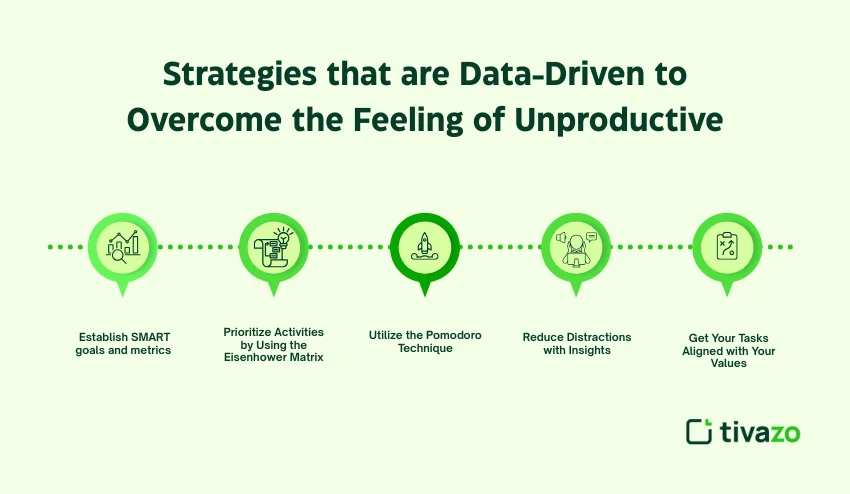
Consider Data to Review and Reflect
1. Weekly Analysis
What if several data points could point to the real reason behind your unproductive use of time? Weekly reviews help you:
- Find recurring periods of low productivity,
- Determine what tasks are using too much time with little results,
- Facilitate scheduling and prioritizing based on data.
2. Measure Outcomes vs. Only Investing in Things
How do you still know if your time and energy are part of the 80% working? To put aside subjective feelings, take some time to compare your investments and results:
| Task | Hours Invested | Result/Impact |
| Marketing Emails | 2 | 5 generated leads |
| Client Analysis Report | 3 | Critical insights provided |
| Meetings | 2 | Decisions delayed – would have been provided if planned more time |
Concentrate on tasks you invested the largest amount of time and energy into, and plan what matters.
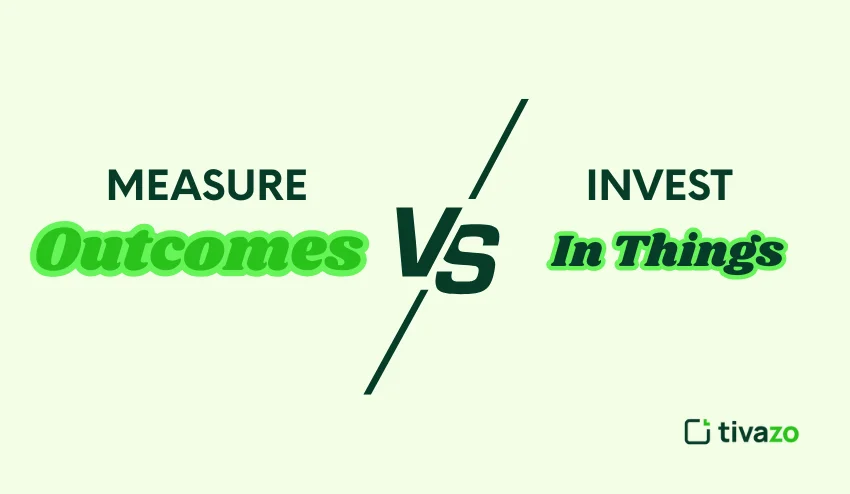
Practical Tips to Avoid Feeling Unproductive
1. Scheme for Deep Work
Reserve 2–3 hours every day in your schedule for focused work. Deep work plans permit you to work on your most pressing projects and tasks, completely free from distraction, while reducing the feeling unproductive. Use your calendar to reserve time and treat it like it’s an appointment – non-negotiable.
2. Automate Repetitive Tasks
Use some sort of automation (scripts, templates, or software-based automation) to do your routine work. Automating repetitive work not only saves time but also prevents the fatigue that can arise from doing routine work. With fewer routine tasks draining your energy, the feeling unproductive declines, allowing you to focus on your highest value work.
3. Record Weekly Wins
Keep track of small wins to keep you motivated. Some weekly reflection allows you to better see measured progress, even in weeks where some days are more productive than others. Similarly, keeping track of wins will be a constant resistance to the common but incorrect thinking that “being busy” equals being productive, which likewise declines your feeling unproductive.
4. Physical Activity and Mindfulness
Regular physical activity can help to energize the body, focus the mind, and create mental clarity. Though short walks or breathing exercises may seem insignificant, they help boost cognitive function for more significant periods of productive work. Integrating physical activity or mindfulness techniques into your daily routine means you can feel good about working on meaningful work-related items and feel less overwhelmed or distracted from fatigue.
5. Pro Tip: Micro-goals
Decompose large projects into micro-goals. Structuring your mind to develop small, attainable tasks creates feelings of accomplishment and movement forward. This creates a cushion for those days that are less than optimal, yet still allows you to make progress in your work life.
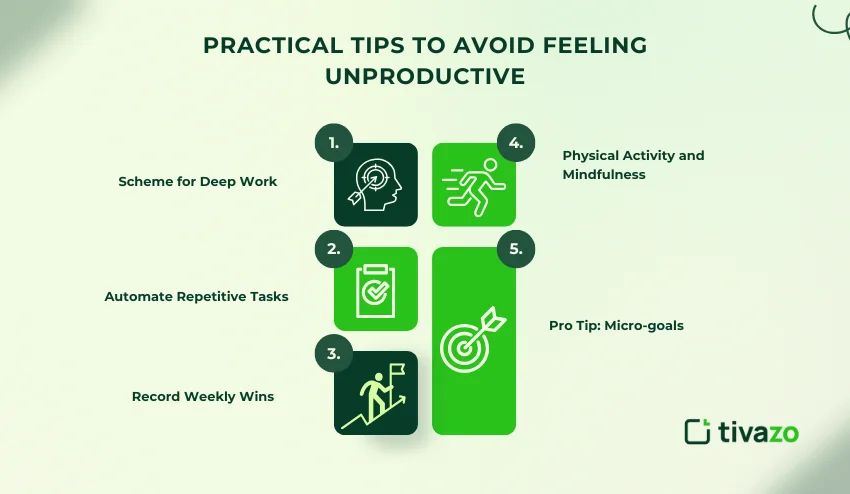
Battling mental blocks and guilt
Often, a sense of unproductivity can evoke guilt. Instead:
- Recognize that breaks are still part of productivity. Breaks and downtime are necessary to remain focused and avoid burnout. Short breaks can help rejuvenate your mind and make it easier to accomplish work, and therefore make you feel productive again.
- Rely on the data you keep to soothe yourself that your day was high-value. Looking at your time logs, tasks completed, and accomplishments will allow you to reflect on your day and see that you have been productive, even if you are feeling unproductive at the time.
- Recognize that guilt is self-created; just focus on improving. Everyone feels unproductive from time to time. Challenge yourself to reflect on the cause that generated the feeling unproductive and then assess your schedule or priorities for the day, and make a small, manageable adjustment for next time.
- Use positive reinforcement, even about the tiniest of accomplishments. If you finished a report or cleared out emails, celebrate that as an accomplishment and use that to reinforce your habits, and build confidence so you can feel less like you’re feeling unproductive.
Conclusion
If you often feeling unproductive, remember this: busy does not equal productive. By recording your time, identifying patterns, prioritizing meaningful work, and applying modest and data-backed interventions, you can narrow your focus and start producing measurable results.
Once you start trusting data, not perception, you will recognize that small changes can help to improve your overall productivity on a day-to-day basis.
Start today. Track your work effort, review your data weekly, and your sense of accomplishment will exponentially improve. Goodbye, unproductive feelings!

